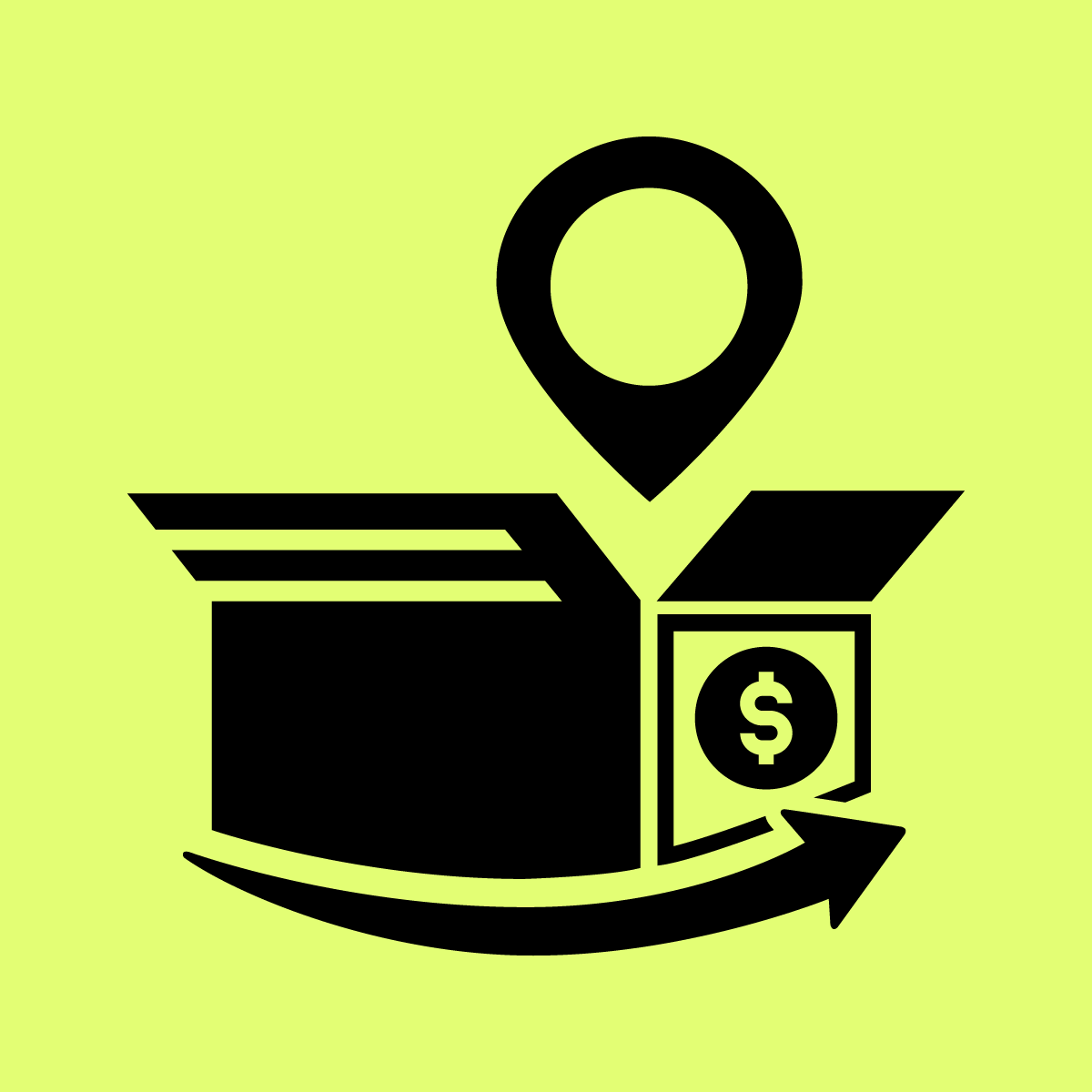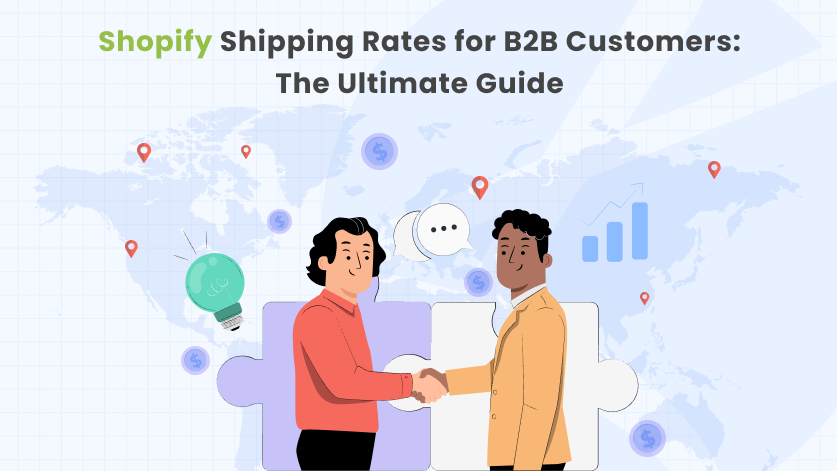Shipping rates are important for any business, but Shopify shipping rates for B2B customers are especially important. They are for business-to-business (B2B) customers who need to place large orders and depend on fast delivery times to keep their business running smoothly.
Also, in B2B eCommerce, shipping rates can make or break a sale. Businesses that sell their products online through Shopify must provide competitive shipping rates to attract and retain B2B customers.
But how can you change your shipping rates that fit your B2B customers? You can do that with the help of the Shopify Shipping Customization app.
In this complete guide, we’ll go over everything you need to know about Shopify shipping rates for business-to-business (B2B) customers.
In this guide, we’ll talk about how important it is to have competitive rates, look at the different options on Shopify, and show how to use the Shopify shipping customization app to set up custom shipping rates on Shopify that meet the needs of your B2B customer.
This guide will help you improve your shipping plan and increase your B2B sales, no matter how long you’ve been using Shopify or if you’re just starting out.
Understanding B2B Shopify Shipping Rates on Shopify:
There are big differences between B2B and B2C deals when it comes to Shopify shipping rates.
As a Shopify business owner, it’s important to understand these differences so you can accurately price your products and monitor your shipping rates.
1. Weight:
The distinction between B2B and B2C shipping rates on Shopify primarily lies in the weight of the items being transported most things in B2B transactions are much bigger and heavier than those in B2C transactions, which has a big effect on shipping costs.
For example: A recent study found that the average weight of a (B2B) order is much lower than a (B2C) order.
Due to the heavy weight and size of the items being shipped, B2B shipping rates tend to be higher than B2C shipping rates.
2. Destination:
Another significant difference between B2B and B2C shipping rates is the final destination of the product. Most B2B orders are shipped to business addresses, such as warehouses, retail stores, or other places where people work.
On the other hand, B2C is more likely to be sent to home addresses. This difference can affect shipping rates since business addresses are often easier and cheaper to ship to than residential addresses.
Shippo did a study that found that shipping to a home/residential area can cost up to 30% more than shipping to a business.
3. Shipping Requirements:
Finally, shipping requirements for B2B deals are often more complicated, such as the need for special packaging or handling.
For example: B2B orders may need temperature-controlled packaging, special handling of hazardous materials, or other special shipping plans.
These requirements can have a big effect on shipping rates, especially for foreign shipments. Nicholas Sly says that 15% of B2B companies said their shipping prices had gone up because of changes in international shipping rules.
To summarize, here is a table that outlines the main differences between B2B and B2C shipping rates on Shopify:
As a business owner on Shopify, understanding these differences can help you accurately price your products and manage your shipping rates.
By factoring in the weight of your products, the destination of your shipping, and any special requirements, you can ensure that you are charging the right amount for cost and avoiding any unexpected expenses.
Factors that Impact B2B Shipping Rate in Shopify:
Shopify shipping rates can have a big effect on how much money B2B eCommerce businesses make. Online stores must understand the factors that affect these rates in order to improve their shipping tactics and cut costs.
1. Distance:
Distance is one of the most important things that affect B2B shipping rates. The distance can have a big effect on how much shipping costs.
So, when you figure out their shipping rates, businesses have to think about where their buyers live. Also, companies may charge extra fees for shipping to rural or remote areas, which can add to the cost.
2. Weight and Size:
Another thing that can affect B2B shipping rates is how heavy and big the package is. Carriers typically apply higher charges for larger or heavier packages due to the increased space they occupy and the additional assistance required to transport them.
To cut down on these costs, businesses should think about ways to improve their packing and get rid of extra weight and space. This can be done by choosing the right size box, using materials that are light, and not using too much packing.
3. Shipping Methods:
Finally, the shipping method and service you choose can have a big effect on the B2B Shopify shipping rates.
Shippo did a study that found that businesses can save up to 60% on shipping costs by picking the right carrier and level of service.
For example: USPS Priority Mail can be a cheap way to send small, light packages, while FedEx Ground might be a better choice for bigger, heavier products.
In certain cases, certain carriers may offer discounted rates to high-volume shippers. This can result in significant cost savings for businesses with frequent shipping requirements.
By taking these things into account and choosing the right shipping choices, B2B eCommerce businesses can improve their shipping strategies, cut costs, and make more money while making customers happier.
Also Read: Best Shipping Rate App for Shopify Store with Local Delivery & In-Store Pickup
Importance of Understanding Shipping Zones and Carrier Options:
As was said above, effective shipping tactics are a must for any B2B eCommerce store in today’s highly competitive business world.
With more people shopping online and more people wanting faster and cheaper shipping choices, it’s more important than ever to know about shipping zones and carrier options.
As the number of online shoppers increases and the demand for faster and more affordable shipping options grows, understanding shipping zones and carrier options has become more crucial than ever.
The selection of Shopify shipping rates and methods can significantly impact customer satisfaction, retention, and overall revenue.
Shipping zones are a very important part of B2B business. Shipping zones are based on how far away the ship’s starting point is from where it’s going. The cost of shipping will go up the farther away you are.
By knowing where your customers are, you can correctly figure out how much it will cost to ship their orders and offer competitive rates that won’t cut into your profits.
For example: If you ship from the West Coast to the East Coast, your rates will be higher than if you ship within the same area.
Carrier choices are another important thing to think about when shipping from business to business. There are many different providers, and each one has its own pros and cons.
Some companies may only ship to certain areas or types of packages, while others may offer shipping rates that are faster or cheaper. If you know about the different carriers, you can choose the ones that work best for your business and give your users the best value.
Recent trends in B2B shipping rates show that there is more demand for faster and more flexible shipping choices. Many B2B buyers now want the same amount of speed and ease that they get when they shop online.
This means that businesses need to offer a variety of shipping choices, from same-day delivery to regular ground shipping, to meet the different needs of their customers.
Also, shipping methods are becoming more sustainable and friendly to the environment, with more businesses trying to reduce their carbon footprint and waste from packaging.
By staying on top of these trends and knowing about shipping zones and carrier choices, B2B companies can stay competitive and give their customers the best experience possible.
Also Read: Shopify Checklist: 32 ProvenTips to Consider When You Setup a Shopify Store
Strategies for Setting B2B Shipping Rates in Shopify:
As the owner of an eCommerce business, it can take a lot of work to set affordable shipping rates for B2B clients. You want to give cheap shipping options to your customers while making sure your business stays profitable.
Here are Some Tips and Ideas for Setting B2B Shopify Shipping Rates:
- Know your shipping costs: It’s very important to know your shipping costs before you set your shipping rates. Figure out how much it will cost to ship goods based on their size, weight, and distance. This will help you figure out how much you need to charge for shipping, at the very least, to cover your costs.
- Free Shipping: Free shipping is a great way to attract B2B customers and keep them coming back. You can give free shipping to customers who spend more than a certain amount or who sign up for a monthly service. Don’t forget that there is a cost to free shipping, so make sure to figure that into your pricing plan.
- Talk with carriers: Talking with carriers can help you get better rates for your B2B shipping. This is especially important if you ship a lot of things. Compare the prices of different companies and try to work out the best deal with them.
- Use shipping calculators: Shipping calculators can help you give your customers the correct shipping rates. Shopify gives you a number of shipping tools that you can add to your online store. These calculators figure out shipping costs based on the customer’s location, the weight of the item, and the way of shipping.
- Set up shipping zones: A good way to set different shipping rates for different areas is to set up shipping zones.
For example: You can charge more for foreign shipping and less for shipping within the same country. This will help you give your B2B customers more competitive prices and keep you from losing money on shipping costs.
Also Read: Importance of eCommerce Website for your Online Business
How to use Weight-Based and Price-Based Shipping Rates?
When setting shipping rates on Shopify for your B2B eCommerce store, there are a few things you can do to make sure you offer low rates while still making a profit.
Weight-based shipping rates and price-based shipping rates are two other popular ways to figure out shipping costs.
1. Weight-Based Shipping Rates:
The weight of the things being shipped is used to figure out how much it will cost to ship them. Businesses that sell different sizes and weights often use this method.
By setting different rates for different weight ranges, you can make sure that your customers pay a fair price for shipping based on how much it actually costs to ship the things.
This method also lets you change your prices as needed to take into account changes in transport fees or other things that can affect shipping costs.
2. Price-Based Shipping Rates:
Price-based shipping rates, on the other hand, are based on how much all of the things being shipped cost. Businesses that sell expensive or high-end items often use this method because the price of the items is a big part of how much it costs to ship the whole order.
By setting different rates for different price ranges, you can make sure that your customers pay a fair shipping price based on the value of the things. This method also lets you offer free shipping on orders over a certain price, which can be a strong way to get new customers and keep the ones you have.
To set up shipping rates based on weight or price, you must set up your shipping settings in the backend of your store. From there, you can set up shipping zones and carrier choices and make different shipping rates based on weight or price ranges.
You can also set up shipping rules that charge different rates based on things like the number of orders, where they are being sent, or the type of product.
Also Read: How to Sell on Instagram with Shopify using Shoppable Posts?
Understanding Flat Rate Shipping and its Benefits for B2B Customers:
Here are five tips for setting up B2B Shopify shipping rates:
1. Look into what your competitors are doing: If you want to stay competitive, you should find out what your rivals are charging for shipping. Look at similar products and where they are being shipped to get an idea of what a fair rate would be.
2. Set limits for free shipping: You might want to give free shipping on orders that cost more than a certain amount. This can give buyers a reason to buy more and raise the average price of a purchase.
3. Use shipping based on weight: As explained above, Weight-based shipping rates can be more accurate and cost-effective for bigger and heavy items. Customers are charged based on the product’s weight and where it is being sent.
4. Use shipping based on price: Smaller, lighter things may be better suited for shipping rates based on price. Customers are charged based on the price of the goods and where it is being sent. Flat-rate shipping is another choice for B2B customers, especially those who order small items often.
According to a study by Pitney Bowes, 80% of customers are more likely to buy from an online store that offers free shipping, and 86% are more likely to buy if the store offers a flat-rate shipping choice.
Flat-rate shipping makes it easy for customers to budget because they know exactly how much it will cost. By carefully figuring out shipping costs and changing rates as needed, businesses can stay profitable and offer customers shipping rates that are competitive.
5. Optimize your choices for shipping companies: Consider using more than one shipping company to give your customers more choices. This can help you find the most affordable shipping company for each shipment and give you choices for faster delivery.
Also Read: How to Choose the Best eCommerce Platform for your Business
Customizing Shopify Shipping Rates for B2B Customers:
Shipfy: Shipping Rules, is a Shopify shipping customization app designed to assist businesses in creating customized shipping rules such as separate shipping rates and conditions for B2B customers.
By utilizing this app, businesses can streamline their shipping processes, leading to increased ease of sending packages and ultimately resulting in happier customers. With Shipfy, businesses can set up their own shipping rules based on things like order weight, order value, shipping method, and location.
For example: A business may want to give free shipping on orders over a certain amount or charge a flat shipping rate for orders going to a certain region. The app makes it easy to set up these custom shipping rules, and they will be used immediately at checkout.
There are many reasons to use Shopify to customize shipping for B2B. By making custom shipping rules, businesses can give their customers more choices for shipping that fit their needs.
This makes customers happier and keeps them coming back. Custom shipping rules can also help businesses get the most out of their shipping costs and make more money. By charging accurate and fair shipping rates, businesses can avoid overcharging customers and keep their image as honest and trustworthy businesses.
Shipfy Enables B2B Companies to Create Custom Shipping Rules, Including but not limited to:
1. Change the Order of Shipping Rates on the Checkout Page:
This feature lets businesses put certain shipping rates at the top of the list and highlight premium shipping choices during the checkout process. By changing how shipping rates are set up, businesses can help customers choose shipping options that are faster or more reliable. This improves the entire customer experience.
2. Hide the Shipping Choices & Set the Shipping Rate by Collection:
This feature lets businesses hide some shipping choices for certain products or collections of products.
For example: A business may decide to only give express shipping for high-value or fragile items while other items are sent at standard shipping rates.
3. Hide Shipping Rates by Customer Tag & PO Box Addresses:
This tool lets businesses make their own shipping rules based on customer tags or addresses.
For example: A business may choose to hide shipping rates for customers with a certain tag or for PO Box addresses to make sure that their shipping rates are accurate and fair.
4. Rename Multi-Location or Multi-Vendor Shipping Rates:
This tool lets businesses change their shipping rates based on how many locations or vendors are involved in the shipment. Businesses can make it easier for customers to understand their shipping choices by changing the names of the shipping rates.
5. Shipping Hide by Tier Discounted Price Tier:
This feature lets businesses hide shipping methods for customers who have hit a certain price tier or discount level.
For example: A business might decide to hide shipping rates from customers who have spent more than a certain amount. This would encourage those customers to keep buying from the business.
6. Shipping discount:
With this soon-to-come feature, businesses will be able to offer their customers lower shipping rates. This feature can help businesses retain their existing customers and get new customers.
Overall, the Shipfy: Shipping Rules app is a great way for B2B online businesses to meet the needs of their customers by making custom shipping rules. By using this app’s benefits, companies can speed up their shipping processes, make their customers happier, and make more money.
Also Read: BigCommerce vs. Shopify: Which Is Better For Your eCommerce Business?
Best Practices for Offering B2B Shipping Rates on Shopify:
When using Shopify to offer shipping rates for B2B customers, there are a few best practices to keep in mind. By doing these things, companies can be open about their prices, let customers know what they are, and cut shipping costs without sacrificing quality.
First, when it comes to B2B shipping rates, it’s important that everything is clear. Customers want to know what they’re paying for and why. It’s important to let people know about shipping costs right away, ideally on the product page or when they check out. This lets your customers know what to expect and makes them more likely to come back to your shop.
Businesses can tell B2B customers about shipping rates in a number of ways. Customers can learn how shipping rates are figured by using a shipping calculator or estimator. Businesses can also meet the different needs of their B2B customers by giving them different shipping choices, such as standard or express shipping.
Optimizing packing is one way for B2B customers to save money on shipping costs without giving up quality. By using packaging materials that are the right size and weight for each order, companies can reduce the weight and volume of their shipments as a whole, which lowers their shipping costs.
Also, businesses can talk to shipping companies about forming partnerships to get better rates based on the regularity of shipments.
A multi-carrier shipping option is another way to cut down on shipping costs. By using more than one shipping company, a business can compare prices and pick the most affordable choice for each shipment.
This can save a lot of money and give B2B customers shipping options that are fast and reliable.
Conclusion:
In conclusion, offering competitive and transparent shipping rates is an important aspect of B2B eCommerce. Using the right tools and strategies, businesses can provide their customers with personalized shipping options while optimizing shipping costs and increasing profitability.
Shopify offers a variety of shipping rate options for B2B businesses, including weight-based and price-based rates, flat rate shipping, and custom shipping rules through Shopify apps.
By leveraging these tools and best practices, businesses can improve customer satisfaction, increase average order value, and maintain a competitive edge in the market.
If you want to customize your B2B shipping rates on Shopify, try Shipfy: Shipping Rules. This app offers a range of custom shipping rules that can help you streamline your shipping processes and meet the unique needs of your customers.
Get in touch with our Shopify experts at Cirkle Studio to learn more about how we can help you optimize your B2B eCommerce shipping experience.








